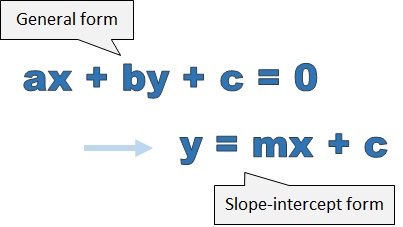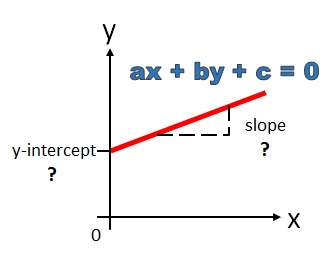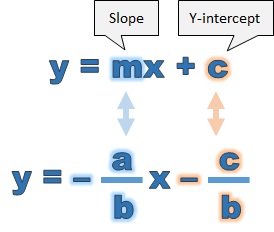Converting a Linear Equation from General to Slope-Intercept Form
(KS4, Year 10)

Why Convert from General Form to Slope-Intercept Form?
The same line can be written in general form and slope-intercept form. The two forms of linear equation tell us different things about the line.-
In general form, a, b and c do not tell us anything about the line.

-
In slope-intercept form,
• m tells us the slope of a line
• c tells us the y-intercept of a line.

How to Convert a Linear Equation from General to Slope-Intercept Form
Using algebra, we can take the general form of a linear equation and make it look like the slope intercept form.-
Start with the linear equation in general form:

-
Subtract ax from both sides. This has the effect of moving the ax to the other side of the equals sign (=) and changing its sign from positive to negative:

-
Subtract c from both sides:

-
Divide both sides by b:


- The slope is given by −a⁄b.
- The y-intercept is given by −c⁄b.
A Real Example of How to Convert a Linear Equation from General to Slope-Intercept Form
Convert the linear equation in general form below to slope-intercept form.Question
Find the y-intercept of the line given by the linear equation shown below.Step-by-Step:
1
Subtract 4x from both sides:
4x + 2y + 6 − 4x = 0 − 4x
2y + 6 = −4x
2
Subtract 6 from both sides:
2y + 6 − 6 = − 4x − 6
2y = −4x − 6
3
Divide both sides by 2:
2y ÷ 2 = (− 4x − 6) ÷ 2
y = −2x − 3
Answer:
We have converted 4x + 2y + 6 (in general form) to y = −2x − 3 (in slope-intercept form).Worksheet
This test is printable and sendable






